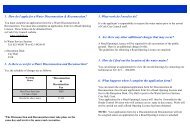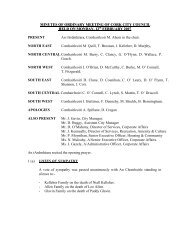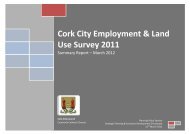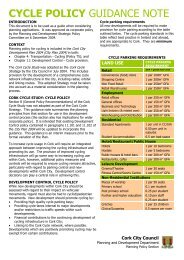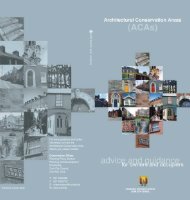Untitled - Cork City Council
Untitled - Cork City Council
Untitled - Cork City Council
Create successful ePaper yourself
Turn your PDF publications into a flip-book with our unique Google optimized e-Paper software.
Appendix 5 : Guidance on Retail Impact Assessment<br />
Retail Impact Assessment Guidance<br />
1. Retail Impact Assessment is a tool used by Planning Authorities and applicants for<br />
permission for substantial retail developments to understand and justify the addition of<br />
particular retail development in the context of the detailed strategy and the emerging<br />
urban context into which the development must integrate without causing significant<br />
disruption.<br />
2. The National Spatial Strategy has set out a structure for the future urbanisation of the Irish<br />
population, with a hierarchy of urban centres providing critical mass to sustain a range of<br />
quality of life services, including a good quality retail environment. In an increasingly<br />
urbanised and wealthy environment, retail is an essential service, a generator of<br />
economic activity and employment and often times a catalyst for urban centre<br />
redevelopment or expansion to meet the needs of enlarged urban areas.<br />
3. The hierarchy of strategic and statutory development plans set the broad context for<br />
scale, type and location of retail developments. For <strong>Cork</strong>, this structure has been set out<br />
in the Retail Strategy, which is incorporated into the <strong>City</strong> & County Development Plans in<br />
the first instance and is more specifically reflected in the local area plans.<br />
4. Therefore, the first source of guidance on retail acceptability should be based in the<br />
strategic and statutory plans that apply to a particular area. The Retail Hierarchy for <strong>Cork</strong><br />
<strong>City</strong> & County have been set out in the main body of the <strong>Cork</strong> Strategic Retail Study,<br />
which also includes the primary criteria for development control with emphasis upon the<br />
sequential approach, maintenance of vitality and viability of existing centres and<br />
promoting accessibility.<br />
5. The purpose of Retail Impact Assessment is to focus upon the potential impact upon the<br />
pattern of retailing in established centres in a catchment area, without focussing on<br />
individual retail businesses or interfering with normal competition. As indicated in the<br />
Retail Planning Guidelines (Para. 57) where an application for development complies with<br />
the policies and proposals of a Development Plan in all material aspects it should not<br />
necessary for the applicant to provide additional supporting background studies.<br />
Therefore, retail developments within town centres should only require a detailed<br />
quantative and qualitative Retail Impact Assessment in exceptional circumstances.<br />
6. Retailing is a dynamic industry subject to constant change, renewal and significant<br />
expansion where the population is rapidly urbanising. Retail addition to town centres is<br />
often a strategic advantage with long-term beneficial effects that should be taken into<br />
account. Retail capacity should not be assessed on a primarily mathematically basis but<br />
should be assessed by appropriateness of type and format for the particular centre. A<br />
detailed Retail Impact Assessment should not be necessary for developments within the<br />
city centre, suburbs, metropolitan and ring towns for developments below 2,500m 2 gross<br />
comparison goods and 1,000m 2 convenience goods.<br />
7. Retail Impact Assessment is an aid to decision making and should not be the sole basis<br />
upon which an application for significant retail development should be determined. The<br />
overall Retail Assessment should encompass: a sequential location assessment, an<br />
assessment of need and a quantification of impact.<br />
8. The qualitative element should include a justification of location, based on the sequential<br />
test, with onus on the applicant to demonstrate that no more suitable sites are available<br />
within a reasonable period of time. Centrality of development must take into account the<br />
suitability of development for a central location.<br />
9. Availability should take into account whether particular central sites are available to the<br />
market, whether there is potential for site assembly and the engagement of the Local<br />
Authority in expansion, regeneration and renewal of town centres.<br />
10. Taking into account the urban and retail hierarchy, retail development should be<br />
appropriate for the size and function of the town and its catchment area. Retail<br />
1



